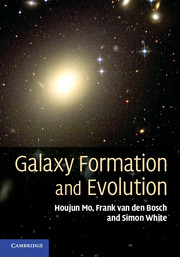Book contents
- Frontmatter
- Contents
- Preface
- 1 Introduction
- 2 Observational Facts
- 3 Cosmological Background
- 4 Cosmological Perturbations
- 5 Gravitational Collapse and Collisionless Dynamics
- 6 Probing the Cosmic Density Field
- 7 Formation and Structure of Dark Matter Halos
- 8 Formation and Evolution of Gaseous Halos
- 9 Star Formation in Galaxies
- 10 Stellar Populations and Chemical Evolution
- 11 Disk Galaxies
- 12 Galaxy Interactions and Transformations
- 13 Elliptical Galaxies
- 14 Active Galaxies
- 15 Statistical Properties of the Galaxy Population
- 16 The Intergalactic Medium
- A Basics of General Relativity
- B Gas and Radiative Processes
- C Numerical Simulations
- D Frequently Used Abbreviations
- E Useful Numbers
- References
- Index
4 - Cosmological Perturbations
Published online by Cambridge University Press: 05 June 2012
- Frontmatter
- Contents
- Preface
- 1 Introduction
- 2 Observational Facts
- 3 Cosmological Background
- 4 Cosmological Perturbations
- 5 Gravitational Collapse and Collisionless Dynamics
- 6 Probing the Cosmic Density Field
- 7 Formation and Structure of Dark Matter Halos
- 8 Formation and Evolution of Gaseous Halos
- 9 Star Formation in Galaxies
- 10 Stellar Populations and Chemical Evolution
- 11 Disk Galaxies
- 12 Galaxy Interactions and Transformations
- 13 Elliptical Galaxies
- 14 Active Galaxies
- 15 Statistical Properties of the Galaxy Population
- 16 The Intergalactic Medium
- A Basics of General Relativity
- B Gas and Radiative Processes
- C Numerical Simulations
- D Frequently Used Abbreviations
- E Useful Numbers
- References
- Index
Summary
In the standard model of cosmology described in the previous chapter, the Universe is assumed to be highly homogeneous at early times. The structures observed today, such as galaxies and the clusters of galaxies, are assumed to have grown from small initial density perturbations due to the action of gravity. In this scenario, structure formation in the Universe involves the following two aspects: (i) the properties and origin of the initial density perturbations, and (ii) the time evolution of the cosmological perturbations in an expanding Universe.
In this chapter we examine the origin of cosmological perturbations and their evolution in the regime where the amplitudes of the perturbations are small. We begin in §4.1 with a description of Newtonian perturbation theory in the linear regime. This applies to structures with sizes much smaller than the horizon size, so that causality can be considered instantaneous, and with a density contrast relative to the background much smaller than unity. The relativistic theory of small perturbations is dealt with in §4.2. This is an extension of the Newtonian perturbation theory, and is required when considering perturbations larger than the horizon size or when the matter content of the perturbations cannot be treated as a non-relativistic fluid. For a Universe with a given matter content, the theories presented in these two sections allow one to trace the time evolution of the cosmological perturbations in the linear regime. The nonlinear evolution will be discussed in Chapter 5.
- Type
- Chapter
- Information
- Galaxy Formation and Evolution , pp. 162 - 214Publisher: Cambridge University PressPrint publication year: 2010



